It is an art that knew how to live, and equally, and art that knows how to die. The totem poles of the Pacific are vanishing into the earth.
The last totem poles stand on deserted beaches on the edge of cedar forests. Gazing out to the sea, only a few are left now, among the hundreds of wooded islands that dot the Pacific coast from Vancouver Island to Alaska; over a thousand miles of jagged coastline, where snow capped mountains plunge into a sea.
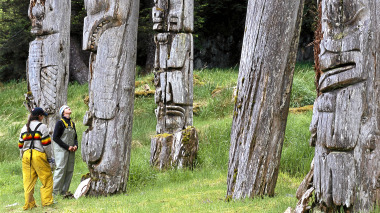
Bruce Kirkby:Haida Gwaii is the homeland of the Haida, the West Coast's most prosperous first nation, a people renowned for their artistry, their seamanship and their ferocity. Wander in the woods and you are likely to stumble upon murmurs of this past: moss-covered canoes, cedar with strips of bark removed, middens (heaps of discarded shells). Most famously, at SGaang Gwaii, near the archipelago's southernmost cape, is a grove of hauntingly beautiful cedar mortuary poles, slowly but steadily decaying. Consumed by the elements, in Haida tradition they are being left to return to the soil of their birth. Read More:http://www.theglobeandmail.com/life/travel/news-and-trends/bruce-kirkby/the-galapagos-of-the-north-gwaii-haanas-national-park/article2037342/
Until the beginning of the twentieth century, many of the Indian villages in this region had veritible forests of totem poles on their landing beaches. In Tuxekan, a visitor in 1916 counted one hundred and twenty-five of them. But Christianity opposed them. Forgive them, for they know not what they do. The missionaries did not know have the foresight to care that they were heraldic crests and images of memory rather than heathen idols. Seeing one of these great sculptures swaying in the wind, the power of their stare, the Christian soldiers attitude was understandable.
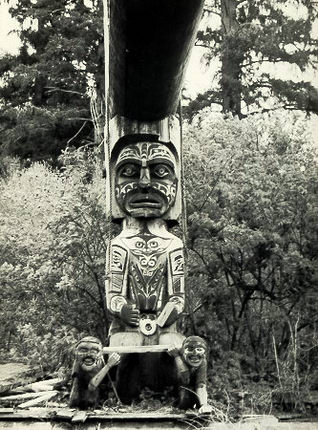
The Kwakwaka'wakw house post at Xwatis (Koskimo) on Vancouver Island was carved by Quatsino artist George Nelson in 1906. It is an ancestral figure with a whale on its chest and coppers on its arms. The Koskimo house post was photographed in situ c. 1914 by Edward S. Curtis for his multivolume book "The North American Indian" (1907 - 1930). By 1955, the post was all that remained of the Sea Lion House at Xwatis. Today it and other artifacts from the potlatch celebration including the dance curtain, headdress, talking stick and the masks are in the University of British Columbia's Museum of Anthropology. Read More:http://www.cathedralgrove.eu/text/07-Totem-Websites-6.htm
The missionaries were followed by anthropologists and museums to do more cutting down, though from other motives. Same result. Foraging into the most remote and nearly inaccessible places, such as Anthony Island, the last salvageable poles were put under protective custody. Under house arrest, they are at U.B.C., New York or the British Museum, which has a marble staircase winding around a three story Haida pole from the Queen Charlotte Islands, perhaps the finest in existence.
As a result, the coast as whole has been pretty well stripped clean of its primitive art. Beginnning with Andre Breton, and then Nelson Rockefeller, there was a great northwestern coast art rush in which objects such as a Tlingit dance mask became unobtainable at any price. Whatever was left on the coast after missionizing, theft,and souvenir hunting was sluiced down to the large galleries and auction houses, whether portable or of the ten ton variety.
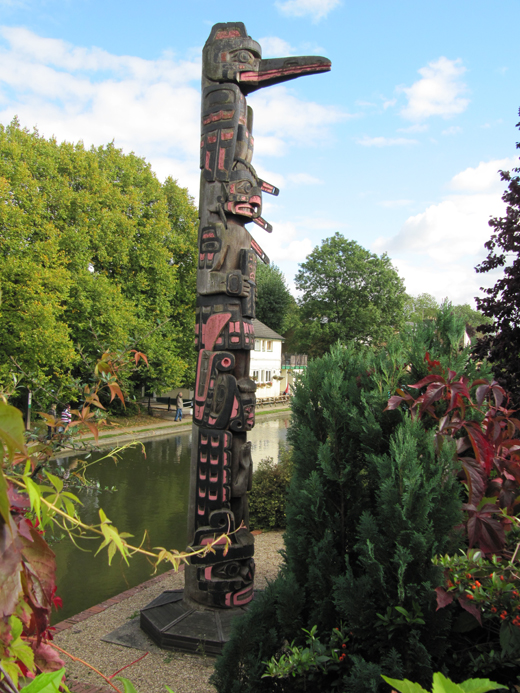
---The totem pole is located on a a housing estate at Berkhamsted next to the Grand Union Canal (between London & Birmingham). Earlier the property had been the site of a commercial wood yard. To advertise his wood products, the owner commissioned a totem pole by two Kwakiutl artists from Tsaxis (Fort Rupert): the well known carver Henry Hunt (1923 - 1985), who had apprenticed under Mungo Martin, and his son Tony Hunt (b. 1942). They carved the pole on Vancouver Island and sent the finished sculpture to Britain. Reference: John Tearle, The Berkhamsted Totem Pole (1998). From Charles Brooks.--- read more:http://www.cathedralgrove.eu/text/07-Totem-Websites-6.htm image:http://www.concept-design.co.uk/?p=913
Ironically, most of this art was originally made for the express purpose of being given away, since the way to acquire status in this part of the world, in the old days, was to amass a hoard of beautiful things and then hand them over to other people at one of their great belching, brawling potlach banquets. This was not quite as selfless as it sounds. The gift giving became compulsive when potlaching replaced tribal warfare as a way of settling disputes and rival chiefs were forced to outshine each other in periodic orgies of largesse.
It was that rare and curious phenomenon, a materialist but nonacquisitive society. The artists it produced were probably the greatest wood sculptors of all time and the most gifted depictors of the face. Nothing else in the realm of wood sculpture can quite compare with the magnificent classicism of these masks and totems. The Congo carvers, though no less imaginative, tend to be far more nervous and arbitrary in their forms, while the Gothic sculptors of Europe could muster none of the magic powers of the totem; their scale is small and hedged about with inhibitions, as the pear tree is to the giant cedar.
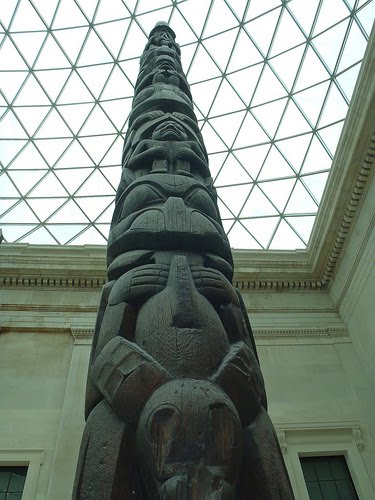
The towering Haida totem pole at the British Museum, is a certainly one of the most striking features in the Great Court at the centre of the building. It stands 39 feet high and was carved from a single cedar trunk. Made by the native American Haida people of
ang, near Masset, on Queen Charlotte Island in Canada, when Charles Frederick Newcombe acquired it for the Museum in 1903, it was already around fifty years old. The pole, we are told, tells the story of the lazy son-in-law, and is topped off with a representation of the Haida house chief, holding his club. Read More:http://www.tiredoflondontiredoflife.com/2011/01/marvel-at-british-museum-totem-poles.htmlADDENDUM:
“Low Man on the Totem Pole”
Such a common expression, and so incorrect …. one wonders how it persists. At first glance it might appear that the lowest figure on a totem pole, has the weight of an entire menagerie on top, and obviously lacks status. Go surfing the Internet to any number of academic sites and see the number of acamedians who whistfully refer to themselves as “low man on the totem pole.” Interestingly enough, the low end of the totem pole is very important. Totem poles are carved, not by one carver, but by a chief carver and a number of apprentices. The chief carver is well aware that the viewers of a finished upright pole, range in size from 3 feet (children) to about 7 feet (basketball players.)…
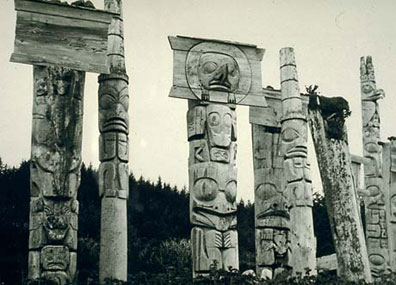
---"The Kwakiutl artist painting on a hide did not concern himself with the inconsequentials that made up the opulent social rivalries of the Northwest Coast Indian scene, nor did he, in the name of a higher purity, renounce the living world for the meaningless materialism of design. The abstract shape he used, his entire plastic language, was directed by a ritualistic will towards metaphysical understanding. The everyday realities he left to the toymakers; the pleasant play of non-objective pattern to the women basket weavers. To him a shape was a living thing, a vehicle for an abstract thought-complex, a carrier of the awesome feelings he felt before the terror of the unknowable." -Barnett Newman , The Ideographic Picture 1947--- Read More:http://www.portlandart.net/archives/2007/12/barnett_newman.html
…So, to be certain the totem looks professional and well-executed, the chief carver personally carves the bottom ten feet of the pole and allows the inexperienced apprentices to carve the higher regions. The most intricate and best carved figures are usually placed on the bottom end with the story thinning out towards the top. Many poles (but certainly not all of them!) are topped off with Thunderbird, sort of a generic capper figure, something like a Christmas star, who often has far less meaning than all the carefully thought out symbolic creatures carved into the lower regions. If anything, the lower figures on a totem pole are slightly more important. Read More:http://www.nativeonline.com/totem_poles.htm
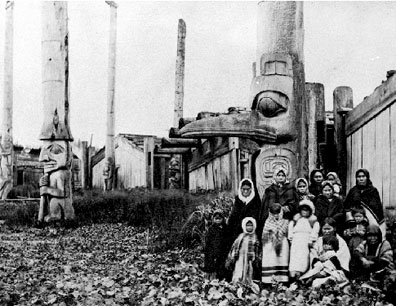
---If the totems were mistakenly seen to be formal, Newman probably felt that the best way to create a similar response in his own work would be to have a formal solution as well. Newman was not the first artist to be looking at tribal art to influence or inspire his own work. Gauguin had moved to Tahiti (twice) to get to a state of mind that would allow his work to have the same power and directness as the work that he would find in flea markets in Paris. Twenty years later Picasso and Matisse were browsing the same flea markets looking for inspirations or parallels to their own work. In the thirties, the Surrealists that frequented Peggy Guggenheim's gallery Art of this Century, especially Max Ernst, began using tribal art as objects in their own paintings. It is interesting that in each case, with the possible exception of Picasso, tribal art was always treated as a formal object that could be depicted or represented. An object, like objectivity, is by definition different or outside of yourself. --- Read More:http://www.portlandart.net/archives/2007/12/barnett_newman.html
a







 COMMENTS
COMMENTS



